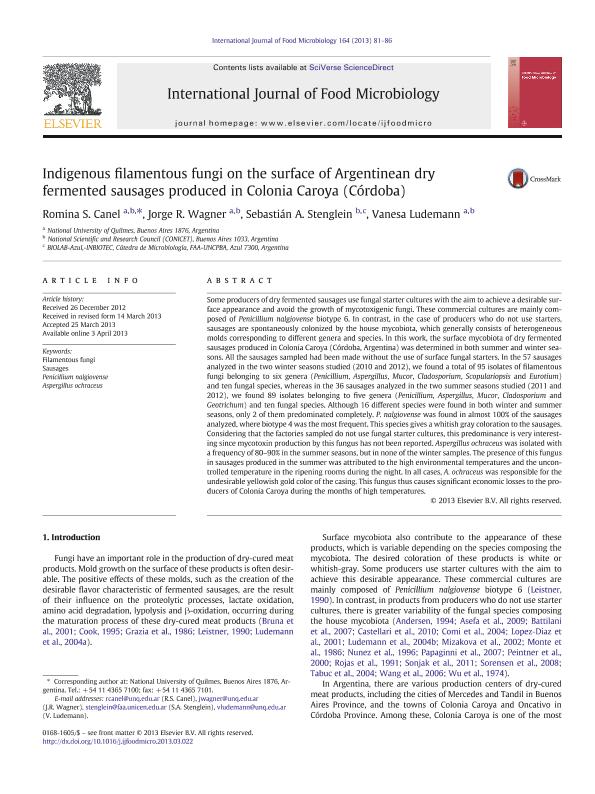Mostrar el registro sencillo del ítem
dc.contributor.author
Canel, Romina Soledad

dc.contributor.author
Wagner, Jorge Ricardo

dc.contributor.author
Stenglein, Sebastian Alberto

dc.contributor.author
Ludemann, Vanesa

dc.date.available
2020-01-10T18:30:50Z
dc.date.issued
2013-06
dc.identifier.citation
Canel, Romina Soledad; Wagner, Jorge Ricardo; Stenglein, Sebastian Alberto; Ludemann, Vanesa; Indigenous filamentous fungi on the surface of Argentinean dry fermented sausages produced in Colonia Caroya (Córdoba); Elsevier Science; International Journal of Food Microbiology; 164; 1; 6-2013; 81-86
dc.identifier.issn
0168-1605
dc.identifier.uri
http://hdl.handle.net/11336/94317
dc.description.abstract
Some producers of dry fermented sausages use fungal starter cultures with the aim to achieve a desirable surface appearance and avoid the growth of mycotoxigenic fungi. These commercial cultures are mainly composed of Penicillium nalgiovense biotype 6. In contrast, in the case of producers who do not use starters, sausages are spontaneously colonized by the house mycobiota, which generally consists of heterogeneous molds corresponding to different genera and species. In this work, the surface mycobiota of dry fermented sausages produced in Colonia Caroya (Córdoba, Argentina) was determined in both summer and winter seasons. All the sausages sampled had been made without the use of surface fungal starters. In the 57 sausages analyzed in the two winter seasons studied (2010 and 2012), we found a total of 95 isolates of filamentous fungi belonging to six genera (Penicillium, Aspergillus, Mucor, Cladosporium, Scopulariopsis and Eurotium) and ten fungal species, whereas in the 36 sausages analyzed in the two summer seasons studied (2011 and 2012), we found 89 isolates belonging to five genera (Penicillium, Aspergillus, Mucor, Cladosporium and Geotrichum) and ten fungal species. Although 16 different species were found in both winter and summer seasons, only 2 of them predominated completely. P. nalgiovense was found in almost 100% of the sausages analyzed, where biotype 4 was the most frequent. This species gives a whitish gray coloration to the sausages. Considering that the factories sampled do not use fungal starter cultures, this predominance is very interesting since mycotoxin production by this fungus has not been reported. Aspergillus ochraceus was isolated with a frequency of 80–90% in the summer seasons, but in none of the winter samples. The presence of this fungus in sausages produced in the summer was attributed to the high environmental temperatures and the uncontrolled temperature in the ripening rooms during the night. In all cases, A. ochraceus was responsible for the undesirable yellowish gold color of the casing. This fungus thus causes significant economic losses to the producers of Colonia Caroya during the months of high temperatures.
dc.format
application/pdf
dc.language.iso
eng
dc.publisher
Elsevier Science

dc.rights
info:eu-repo/semantics/openAccess
dc.rights.uri
https://creativecommons.org/licenses/by-nc-sa/2.5/ar/
dc.subject
FUNGI
dc.subject
SAUSAGES
dc.subject
PENICILLIUM
dc.subject
ASPERGILLUS
dc.subject.classification
Micología

dc.subject.classification
Ciencias Biológicas

dc.subject.classification
CIENCIAS NATURALES Y EXACTAS

dc.title
Indigenous filamentous fungi on the surface of Argentinean dry fermented sausages produced in Colonia Caroya (Córdoba)
dc.type
info:eu-repo/semantics/article
dc.type
info:ar-repo/semantics/artículo
dc.type
info:eu-repo/semantics/publishedVersion
dc.date.updated
2019-10-17T13:43:23Z
dc.journal.volume
164
dc.journal.number
1
dc.journal.pagination
81-86
dc.journal.pais
Países Bajos

dc.journal.ciudad
Amsterdam
dc.description.fil
Fil: Canel, Romina Soledad. Consejo Nacional de Investigaciones Científicas y Técnicas; Argentina. Universidad Nacional de Quilmes; Argentina
dc.description.fil
Fil: Wagner, Jorge Ricardo. Universidad Nacional de Quilmes; Argentina. Consejo Nacional de Investigaciones Científicas y Técnicas; Argentina
dc.description.fil
Fil: Stenglein, Sebastian Alberto. Consejo Nacional de Investigaciones Científicas y Técnicas. Centro Cientifico Tecnolológico Mar del Plata. Instituto de Investigaciones en Biodiversidad y Biotecnología. Laboratorio de Biología Funcional y Biotecnología; Argentina. Universidad Nacional del Centro de la Provincia de Buenos Aires; Argentina
dc.description.fil
Fil: Ludemann, Vanesa. Consejo Nacional de Investigaciones Científicas y Técnicas; Argentina. Universidad Nacional de Quilmes; Argentina
dc.journal.title
International Journal of Food Microbiology

dc.relation.alternativeid
info:eu-repo/semantics/altIdentifier/doi/http://dx.doi.org/10.1016/j.ijfoodmicro.2013.03.022
dc.relation.alternativeid
info:eu-repo/semantics/altIdentifier/url/https://www.sciencedirect.com/science/article/pii/S0168160513001682
Archivos asociados
